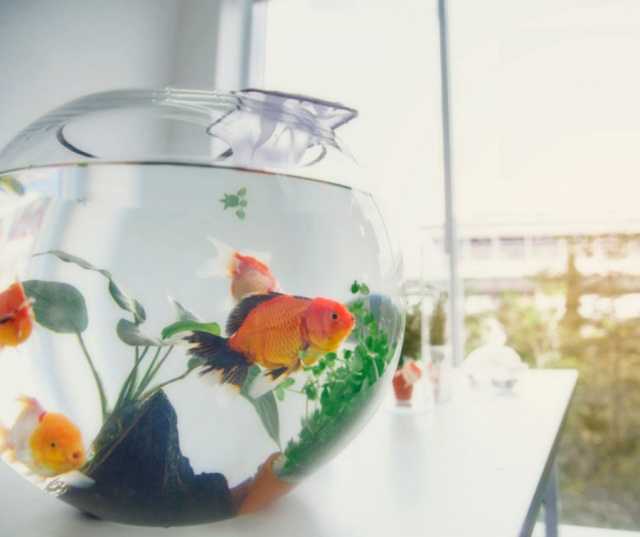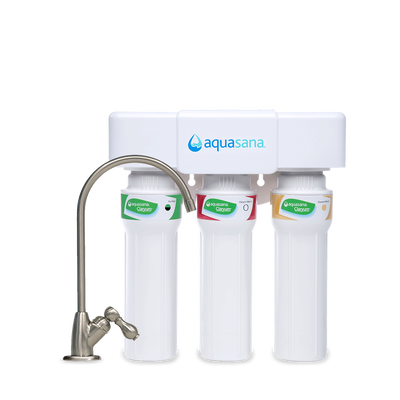It doesn’t take long for a fish owner to amass considerable knowledge about water chemistry. Really, a fish owner is learning and executing the responsibilities of a city water treatment specialist, just on a much, much smaller scale, and for a different end-user. Granted, fish and humans have separate sets of requirements for their water, but that doesn’t stop people from wondering: Does a home water filtration system create fish-friendly water?
The good news is that filtered water can safely be used in freshwater, marine, and reef aquarium systems. For a freshwater aquarium setup, using filtered water that already has chlorine removed will save you the step of having to add dechlorination drops to the water. Also, filtered water already has other contaminants like heavy metals and sediment removed from the water, which makes it ideal for your tank.
The one place where using filtered water gets tricky is that some Reverse Osmosis filters remove everything from the water, including important and very beneficial minerals like calcium, potassium, and magnesium. Just like for humans, these minerals are important for your fish and therefore they will need to be added back in. Luckily, Aquasana's OptimH2O Reverse Osmosis + Claryum system features a remineralizer that automatically adds those important minerals back into the water. That makes for some very happy fish.
If you have a saltwater aquarium setup, starting with filtered water makes it much easier to get the right salt balance. This is because you don't need to account for any salt that might already be in the water when adding salt to the tank. It's like starting from a blank slate. Filtered drinking water can safely be used in freshwater, marine, and reef aquarium systems. Fish use water differently than humans do. When a human takes a sip of water, it works its way through the esophagus and enters the stomach, filtering it before it’s absorbed into the bloodstream. Meanwhile, most fish absorb water through their gills, which sends it directly into the fish’s bloodstream. One option to rid water of chlorine is to let the water stand and allow the chemicals to dissipate, although this does not always lead to chlorine-free water. Sometimes a percentage of chlorine remains in the water even after it sits out for a few days. But what exactly is chloramine? Chloramine, which has actually been used for more than a century, is more widely used as water treatment, touting increased staying power. The only effective method to take chloramine out of water is through a water filter. Home filtration systems that offer reverse osmosis, for example, should take out both chloramines and chlorine. If dealing with chlorine and chloramines in your water were the only factors affecting your fish’s health, home filtration water could potentially work just fine. But there are additional outside factors affecting the water chemistry of a fish tank that is necessary to consider. Not only are pH levels incredibly important to a fish’s health, but also different fish thrive in different pH environments. For example, Tetras, which are small tropical freshwater fish like betas, goldfish, and catfish, thrive in a lower pH environment; Other species prefer high pH environments. The range for pH in drinking water is generally between 6.5 and 8.5 pH, though it may be necessary to alter the pH (higher or lower) so it’s more suitable for fish. Sometimes even if the quality of the fish tank water is great, just the existence of a fish will lead to new chemicals and organisms entering the water. Three of the most common agents to emerge in fish tank water include algae, ammonia, and phosphate, sometimes feeding off each other. Phosphate levels increase as more fish waste and uneaten food is left in the water, especially if there are no plants in the tank. Over time, increased phosphate levels lead to algae growth. Ammonia is most likely to occur when the fish tank is first set up or each time there’s a water change. When new water enters an aquarium, biological colonies begin growing to filter toxins in the water. If these colonies do not grow fast enough, there’s a high chance ammonia levels will rise. And then, there’s tap water. Tap water, filtered or not, has no control over these elements because they only surface once the water has entered the fish tank. So what’s the answer? Filtered water comes with lots of benefits for your fish. Filtering your water will help prevent fish diseases, and keep contaminants out of your tank environment. Additionally, it will be better for any plants you keep in your tank and will help keep the tanks cleaner over the long run. Fish and Chlorine
 For this reason, the most popular chemicals used to treat water, chlorine and chloramines, while relatively safe for humans in the short-term, are toxic to fish. It’s important to note that if water that contains chlorine or chloramine enters a human’s bloodstream directly, it’s also toxic.
For this reason, the most popular chemicals used to treat water, chlorine and chloramines, while relatively safe for humans in the short-term, are toxic to fish. It’s important to note that if water that contains chlorine or chloramine enters a human’s bloodstream directly, it’s also toxic.Balance is everything
Keep your anemones close
Conclusion
